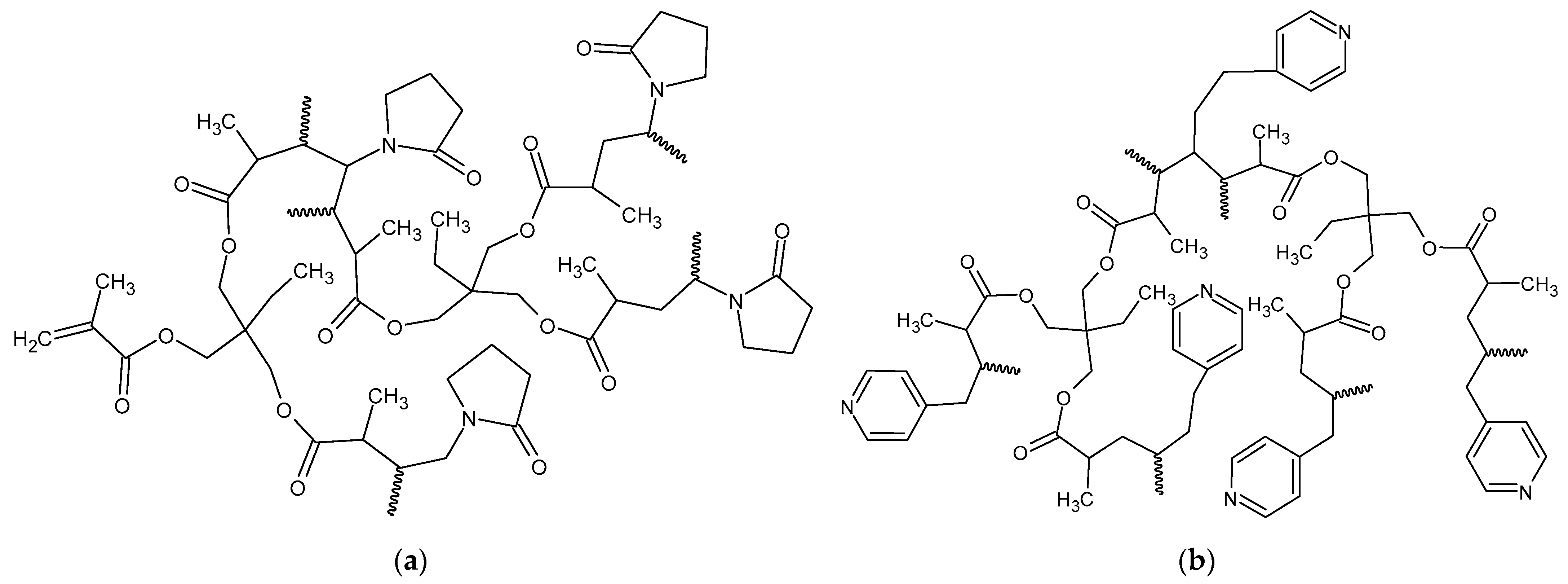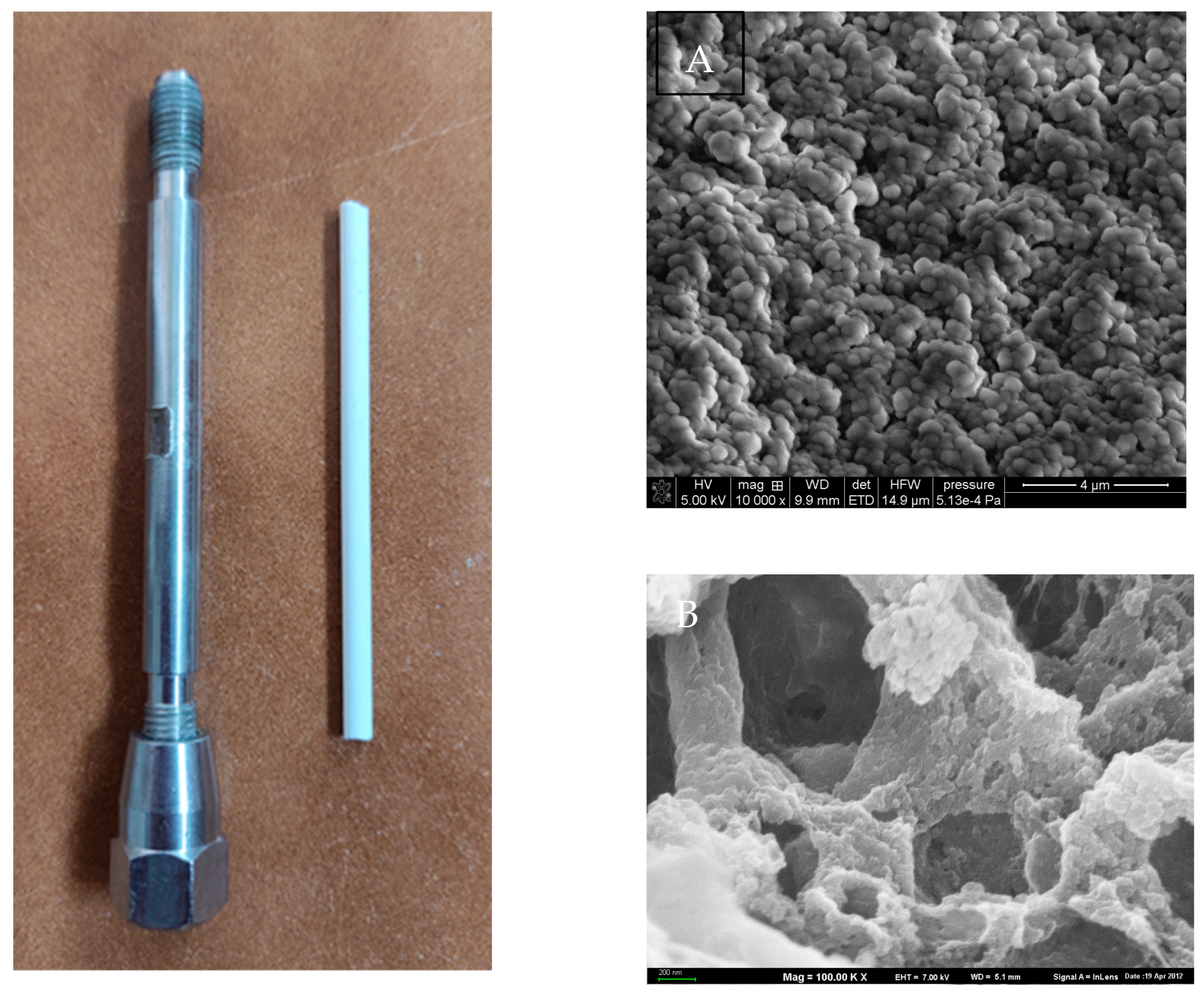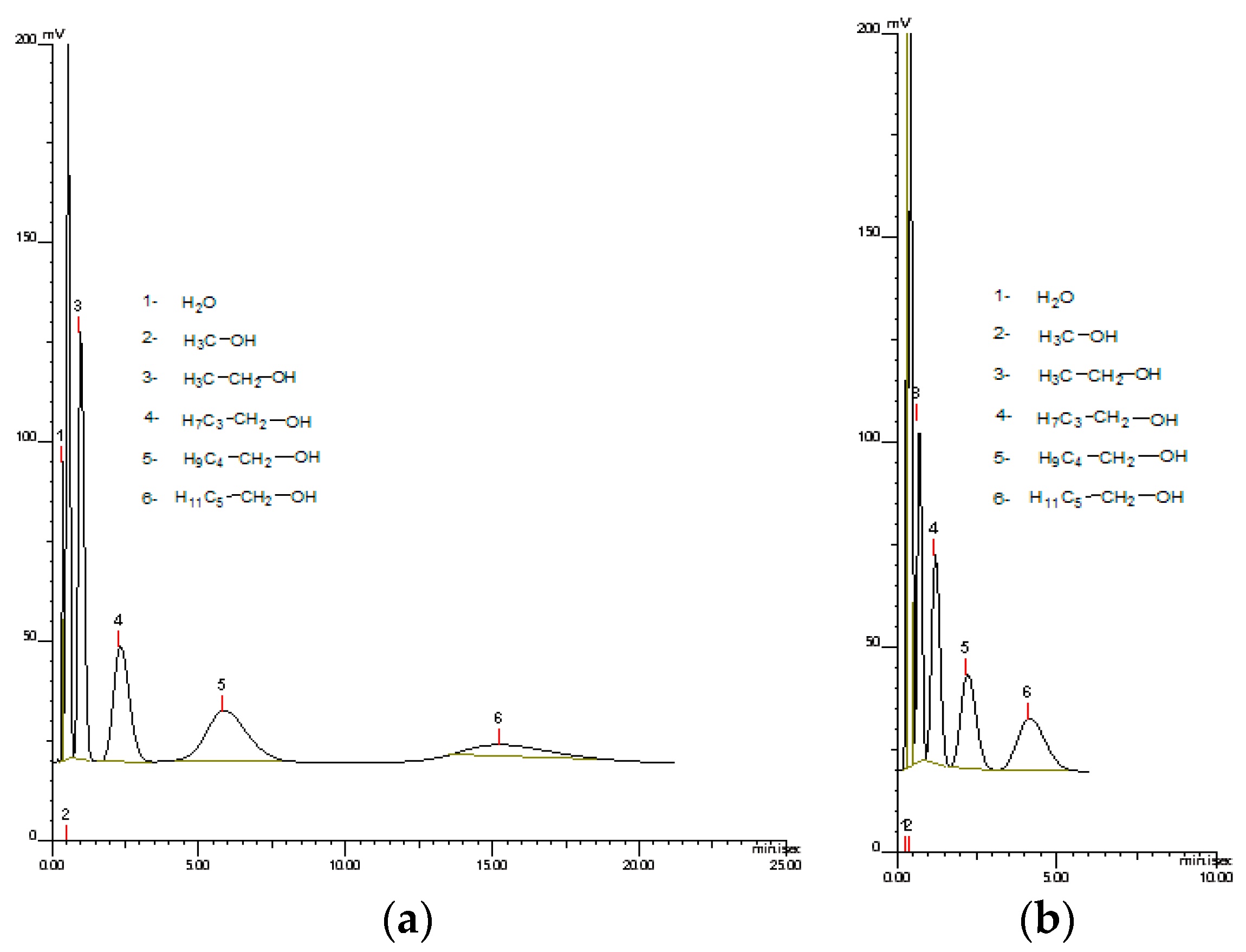Influence of the Polymerization Parameters on the Porosity and Thermal Stability of Polymeric Monoliths
Abstract
1. Introduction
2. Materials and Methods
2.1. Chemicals
2.2. Monolith Synthesis
2.3. Measurement Methods
3. Results
4. Conclusions
Funding
Institutional Review Board Statement
Informed Consent Statement
Data Availability Statement
Conflicts of Interest
References
- Mould, D.L.; Synge, R.L. Electrokinetic ultrafiltration analysis of polysaccaharids-A new approach to the chromatography of large molucules. Analyst 1953, 77, 964–969. [Google Scholar] [CrossRef]
- Svec, F. Preparation and HPLC applications of rigid macroporous organic polymer monoliths. J. Sep. Sci. 2004, 27, 747–766. [Google Scholar] [CrossRef] [PubMed]
- Urban, J.; Eeltink, S.; Jandera, P.; Schoenmakers, P.J. Characterization of polymer-based monolithic capillary columns by inverse size-exclusion chromatography and mercury-intrusion porosimetry. J. Chromatogr. A 2008, 1182, 161–168. [Google Scholar] [CrossRef] [PubMed]
- Svec, F. Stellan Hjertén’s contribution to the development of monolithic stationary phases. Electrophoresis 2008, 29, 1593–1603. [Google Scholar] [CrossRef] [PubMed]
- Viklund, C.; Pontén, E.; Glad, B.; Irgum, K.; Hörstedt, P.; Svec, F. “Molded” Macroporous Poly(glycidyl methacrylate-co-trimethylolpropane trimethacrylate) Materials with Fine Controlled Porous Properties: Preparation of Monoliths Using Photoinitiated Polymerization. Chem. Mater. 1997, 9, 463–471. [Google Scholar] [CrossRef]
- Buchmeiser, M.R. Polymeric monolithic materials: Syntheses, properties, functionalization and applications. Polymer 2007, 48, 2187–2198. [Google Scholar] [CrossRef]
- Tripp, J.A.; Stein, J.A.; Svec, F.; Fréchet, J.M.J. “Reactive Filtration”: Use of Functionalized Porous Polymer Monoliths as Scavengers in Solution-Phase Synthesis. Org. Lett. 2000, 2, 195–198. [Google Scholar] [CrossRef] [PubMed]
- Mallik, R.; Hage, D.S. Affinity monolith chromatography. J. Sep. Sci. 2006, 29, 1686–1704. [Google Scholar] [CrossRef] [PubMed]
- Liu, K.; Aggarwal, P.; Lawson, J.S.; Tolley, H.D.; Lee, M.L. Organic monoliths for high-performance reversed-phase liquid chromatography. J. Sep. Sci. 2013, 36, 2767–2781. [Google Scholar] [CrossRef] [PubMed]
- Liu, Z.; Ou, J.; Liu, Z.; Liu, J. Separation of intact proteins by using polyhedral oligomeric silsesquioxane based hybrid monolithic capillary columns. J. Chromatogr. A 2013, 1317, 138–147. [Google Scholar] [CrossRef]
- Kim, S.-H.; Shin, C.-K.; Ahn, C.-H.; Kim, G.-J. Syntheses and application of silica monolith with bimodal meso/macroscopic pore structure. J. Porous Mater. 2006, 13, 201–205. [Google Scholar] [CrossRef]
- Viklund, C.; Svec, F.; Frechet, J.M.J. Monolithic, “ Molded ”, Porous Materials with High Flow Characteristics for Separations, Catalysis, or Solid-Phase Chemistry: Control of Porous Properties during Polymerization. Chem Mater. 1996, 8, 744–750. [Google Scholar] [CrossRef]
- Svec, F. My favorite materials: Porous polymer monoliths. J. Sep. Sci. 2009, 32, 3–9. [Google Scholar] [CrossRef] [PubMed]
- Cingolani, A.; Cuccato, D.; Storti, G.; Morbidelli, M. Control of Pore Structure in Polymeric Monoliths Prepared from Colloidal Dispersions. Macromol. Mater. Eng. 2018, 303, 1700417. [Google Scholar]
- Müllner, T.; Zankel, A.; Höltzel, A.; Svec, F.; Tallarek, U. Morphological Properties of Methacrylate-Based Polymer Monoliths: From Gel Porosity to Macroscopic Inhomogeneities. Langmuir 2017, 33, 2205–2214. [Google Scholar] [CrossRef] [PubMed]
- Saba, S.A.; Mousavi, M.P.S.; Bůhlmann, P.; Hillmyer, M.A. Hierarchically Porous Polymer Monoliths by Combining Controlled Macro- and Microphase Separation. J. Am. Chem. Soc. 2015, 137, 8896–8899. [Google Scholar] [CrossRef] [PubMed]
- Chirica, G.S.; Remcho, V.T. Novel Monolithic Columns with Templated Porosity. J. Chromatogr. A 2001, 924, 223–232. [Google Scholar] [CrossRef] [PubMed]
- Yu, S.; Ng, F.L.; Ma, K.C.C.; Mon, A.A.; Ng, F.L.; Ng, Y.Y. Effect of porogenic solvent on the porous properties of polymer monoliths. J. Appl. Polym. Sci. 2012, 127, 2641–2647. [Google Scholar] [CrossRef]
- Dores-Sousa, J.L.; Fernández-Pumarega, A.; De Vos, J.; Lämmerhofer, M.; Desmet, G.; Eeltink, S. Guidelines for tuning the macropore structure of monolithic columns for high-performance liquid chromatography. J. Sep. Sci. 2019, 42, 522–533. [Google Scholar] [CrossRef]
- Svec, F. Porous polymer monoliths: Amazingly wide variety of techniques enabling their preparation. J. Chromatogr. A 2010, 1217, 902–924. [Google Scholar] [CrossRef]
- Guiochon, G. Monolithic Columns in High-Performance Liquid Chromatography. J. Chromatogr. A 2007, 1168, 101–168. [Google Scholar] [CrossRef] [PubMed]
- Peters, E.C.; Svec, F.; Fréchet, J.M.J. Rigid Macroporous Polymer Monoliths. Adv. Mater. 1999, 11, 1169–1181. [Google Scholar]
- Schulze, M.W.; Hillmyer, M.A. Tuning Mesoporosity in Cross-Linked Nanostructured Thermosets via Polymerization-Induced Microphase Separation. Macromolecules 2017, 50, 997–1007. [Google Scholar] [CrossRef]
- Lynch, K.B.; Ren, J.; Beckner, M.A.; He, C.; Liu, S. Monolith columns for liquid chromatographic separations of intact proteins: A review of recent advances and applications. Anal. Chim. Acta 2019, 1046, 48–68. [Google Scholar] [CrossRef]
- Eeltink, S.; Meston, D.; Svec, F. Recent developments and applications of polymer monolithic stationary phases. Anal. Sci. Adv. 2021, 2, 250–260. [Google Scholar] [CrossRef] [PubMed]
- Xie, Y.; Hillmyer, M.A. Nanostructured Polymer Monoliths for Biomedical Delivery Applications. ACS Appl. Bio Mater. 2020, 3, 3236–3247. [Google Scholar] [CrossRef]
- Utroša, P.; Žagar, E.; Kovačič, S.; Pahovnik, D. Porous Polystyrene Monoliths Prepared from in Situ Simultaneous Interpenetrating Polymer Networks: Modulation of Morphology by Polymerization Kinetics. Macromolecules 2019, 52, 819–826. [Google Scholar] [CrossRef] [PubMed]
- Mao, Y.; Fan, R.; Li, R.; Ye, X.; Kulozik, U. Flow-through enzymatic reactors using polymer monoliths: From motivation to application. Electrophoresis 2020, 42, 2599–2614. [Google Scholar] [CrossRef] [PubMed]
- Daniels, C.R.; Waguespack, B.L.; Hodges, S.A.; Bushey, M.M. Temperature effects on retention and efficiency of butyl and lauryl acrylate porous polymer monoliths in capillary electrochromatography. J. Sep. Sci. 2019, 42, 3703–3711. [Google Scholar] [CrossRef] [PubMed]
- Kim, D.; Kim, H.J.; Kim, H.; Chang, J.Y. Functional Hierarchical Pores in Polymer Monoliths: Macromolecular Synthesis and Selective Removal of Dyes. ACS Appl. Polym. Mater. 2021, 3, 1385–1394. [Google Scholar] [CrossRef]
- Zunngu, S.S.; Madikizela, L.M.; Chimuka, L.; Mdluli, P.S. Synthesis and application of a molecularly imprinted polymer in the solid-phase extraction of ketoprofen from wastewater. Comptes Rendus Chim. 2017, 20, 585–591. [Google Scholar] [CrossRef]
- Nechvátalová, M.; Urban, J. Current trends in the development of polymer-based monolithic stationary phases. Anal. Sci. Adv. 2022, 3, 154–164. [Google Scholar] [CrossRef] [PubMed]
- Vlakh, E.G.; Tennikova, T.B. Preparation of Methacrylate Monoliths. J. Sep. Sci. 2007, 30, 2801–2813. [Google Scholar] [CrossRef] [PubMed]
- Beneš, M.J.; Horák, D.; Svec, F. Methacrylate-Based Chromatographic Media. J. Sep. Sci. 2005, 28, 1855–1875. [Google Scholar] [CrossRef] [PubMed]
- Maciejewska, M.; Gawdzik, B.; Rogulska, M. Regular polymeric microspheres with highly developed internal structure and remarkable thermal stability. Materials 2021, 14, 2240. [Google Scholar] [CrossRef]
- Maciejewska, M.; Osypiuk-Tomasik, J. Sorption on porous copolymers of 1-vinyl-2-pyrrolidonedivinylbenzene. J. Therm. Anal. Caloim. 2015, 114, 749–755. [Google Scholar] [CrossRef]
- Zaleski, R.; Maciejewska, M.; Puzio, M. Mechanical stability of porous copolymers by positron annihilation lifetime spectroscopy. J. Pchys. Chem. C 2015, 119, 11636–11645. [Google Scholar] [CrossRef]
- Karki, I.; Li, P.; Vik, E.C.; Manzewitsch, A.; Divirgilio, E.; Brewer, W.E.; Shimizu, K.D. Absorption properties of monolithic poly (divinylbenzene-co-N-vinylpyrrolidone) over a wide range of monomer ratios. React. Funct. Polym. 2021, 163, 104888. [Google Scholar] [CrossRef]
- Maciejewska, M. Synthesis and characterization of textural and thermal properties of polymer monoliths. J. Therm. Anal. Calorim. 2015, 121, 1333–1343. [Google Scholar] [CrossRef]
- Grochowicz, M. Investigation of the thermal behavior of 4-vinylpyridine–trimethylolpropane trimethacrylate copolymeric microspheres. J. Therm. Anal. Calorim. 2014, 118, 1603–1611. [Google Scholar] [CrossRef]
- Zhou, L.; He, X.; Qiao, J.; Lian, H.; Ge, X.; Chen, H. A practical interface designed for on-line polymer monolith microextraction: Synthesis and application of poly(4-vinylpyridine-co-ethylene glycol dimethacrylate) monolith. J. Chromatogr. A 2012, 1256, 15–21. [Google Scholar] [CrossRef] [PubMed]
- Grochowicz, M.; Szajnecki, Ł.; Rogulska, M. Crosslinked 4-Vinylpyridine Monodisperse Functional Microspheres for Sorption of Ibuprofen and Ketoprofen. Polymers 2022, 14, 2080. [Google Scholar] [CrossRef] [PubMed]
- Svec, F.; Frechet, J.M.J. Temperature, a simple and efficient tool for the control of pore size distribution in macroporous polymers. Macromolecules 1995, 28, 7580–7752. [Google Scholar] [CrossRef]








| Monolith | Monomers/mmol | Diluents/mL | Temperature /°C | |||
|---|---|---|---|---|---|---|
| TRIM | NVP | 4VP | Cyclohexanol | Decan-1-ol | ||
| M1 | 10 | - | 10 | 10 | 3.5 | 75 |
| M1B | 10 | - | 10 | 10 | 3.5 | 55 |
| M2 | 10 | 10 | - | 10 | 3.5 | 75 |
| M2B | 10 | 10 | - | 10 | 3.5 | 55 |
| M3 | 15 | - | - | 15 | 5 | 75 |
| M3B | 15 | - | - | 15 | 5 | 55 |
| Monolith | Nitrogen Content in the Copolymer (%) | Cross-Linker Content (%) | |
|---|---|---|---|
| Calculated | Determined | ||
| M1 | 3.17 | 3.14 | 50.5 |
| M1B | 3.17 | 3.08 | 51.4 |
| M2 | 3.13 | 2.98 | 52.4 |
| M2B | 3.13 | 2.74 | 56.3 |
| M3 | - | - | 100 |
| M3B | - | - | 100 |
| Monolith | Specific Surface Area SBET (m2/g) | Pore Volume V (cm3/g) | Pore Diameter DBJH (nm) |
|---|---|---|---|
| M1 | 212 | 0.483 | 24 |
| M1B | 92 | 0.248 | 45 |
| M2 | 556 | 0.830 | 20 |
| M2B | 227 | 0.530 | 44 |
| M3 | 598 | 0.871 | 24 |
| M3B | 203 | 0.392 | 2/19/32 |
| Monolith | T5% (°C) | T20% (°C) | T50% (°C) | Tmax1 (°C) | Tmax2 (°C) | Tmax3 (°C) | FDT |
|---|---|---|---|---|---|---|---|
| M1 | 273 | 325 | 342 | 338 | - | - | 484 |
| M1B | 166 | 341 | 396 | 221 | 447 | - | 467 |
| M2 | 274 | 304 | 399 | 290 | 455 | - | 483 |
| M2B | 183 | 283 | 372 | 164 | 283 | 434 | 457 |
| M3 | 342 | 385 | 431 | 450 | - | - | 512 |
| M3B | 142 | 311 | 415 | 232 | 506 | - | 497 |
| Monolith | T5% (°C) | T20% (°C) | T50% (°C) | Tmax1 (°C) | Tmax2 (°C) | Tmax3 (°C) | FDT |
|---|---|---|---|---|---|---|---|
| M1 | 225 | 343 | 388 | 183 | 387 | - | 460 |
| M1B | 183 | 206 | 240 | 217 | 337 | - | 401 |
| M2 | 199 | 350 | 389 | 166 | 378 | 406 | 461 |
| M2B | 180 | 214 | 318 | 216 | 337 | - | 394 |
| M3 | 311 | 326 | 341 | 335 | - | - | 650 |
| M3B | 208 | 257 | 326 | 227 | 339 | - | 548 |
Disclaimer/Publisher’s Note: The statements, opinions and data contained in all publications are solely those of the individual author(s) and contributor(s) and not of MDPI and/or the editor(s). MDPI and/or the editor(s) disclaim responsibility for any injury to people or property resulting from any ideas, methods, instructions or products referred to in the content. |
© 2024 by the author. Licensee MDPI, Basel, Switzerland. This article is an open access article distributed under the terms and conditions of the Creative Commons Attribution (CC BY) license (https://creativecommons.org/licenses/by/4.0/).
Share and Cite
Maciejewska, M. Influence of the Polymerization Parameters on the Porosity and Thermal Stability of Polymeric Monoliths. Materials 2024, 17, 2860. https://doi.org/10.3390/ma17122860
Maciejewska M. Influence of the Polymerization Parameters on the Porosity and Thermal Stability of Polymeric Monoliths. Materials. 2024; 17(12):2860. https://doi.org/10.3390/ma17122860
Chicago/Turabian StyleMaciejewska, Małgorzata. 2024. "Influence of the Polymerization Parameters on the Porosity and Thermal Stability of Polymeric Monoliths" Materials 17, no. 12: 2860. https://doi.org/10.3390/ma17122860
APA StyleMaciejewska, M. (2024). Influence of the Polymerization Parameters on the Porosity and Thermal Stability of Polymeric Monoliths. Materials, 17(12), 2860. https://doi.org/10.3390/ma17122860



.png)



